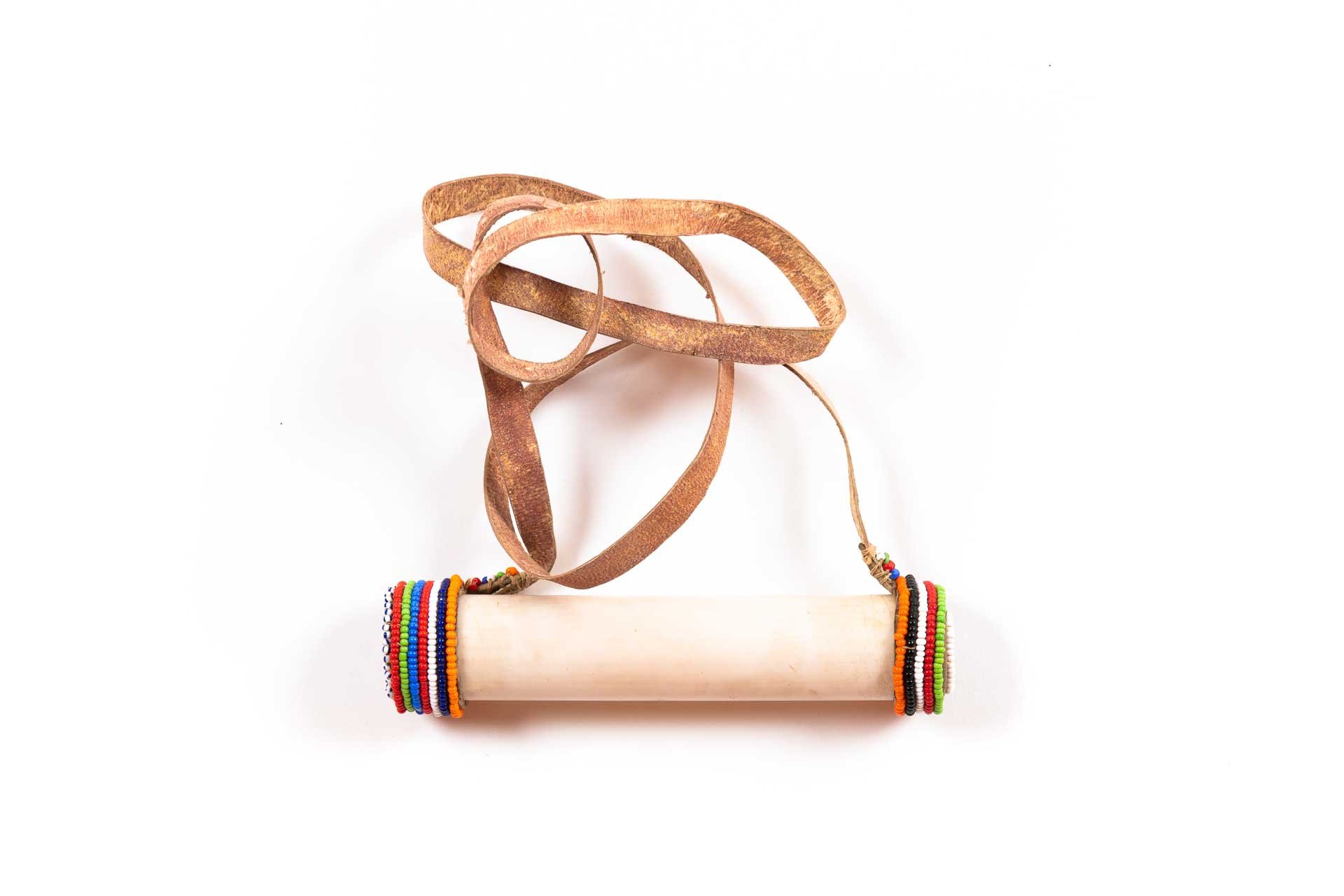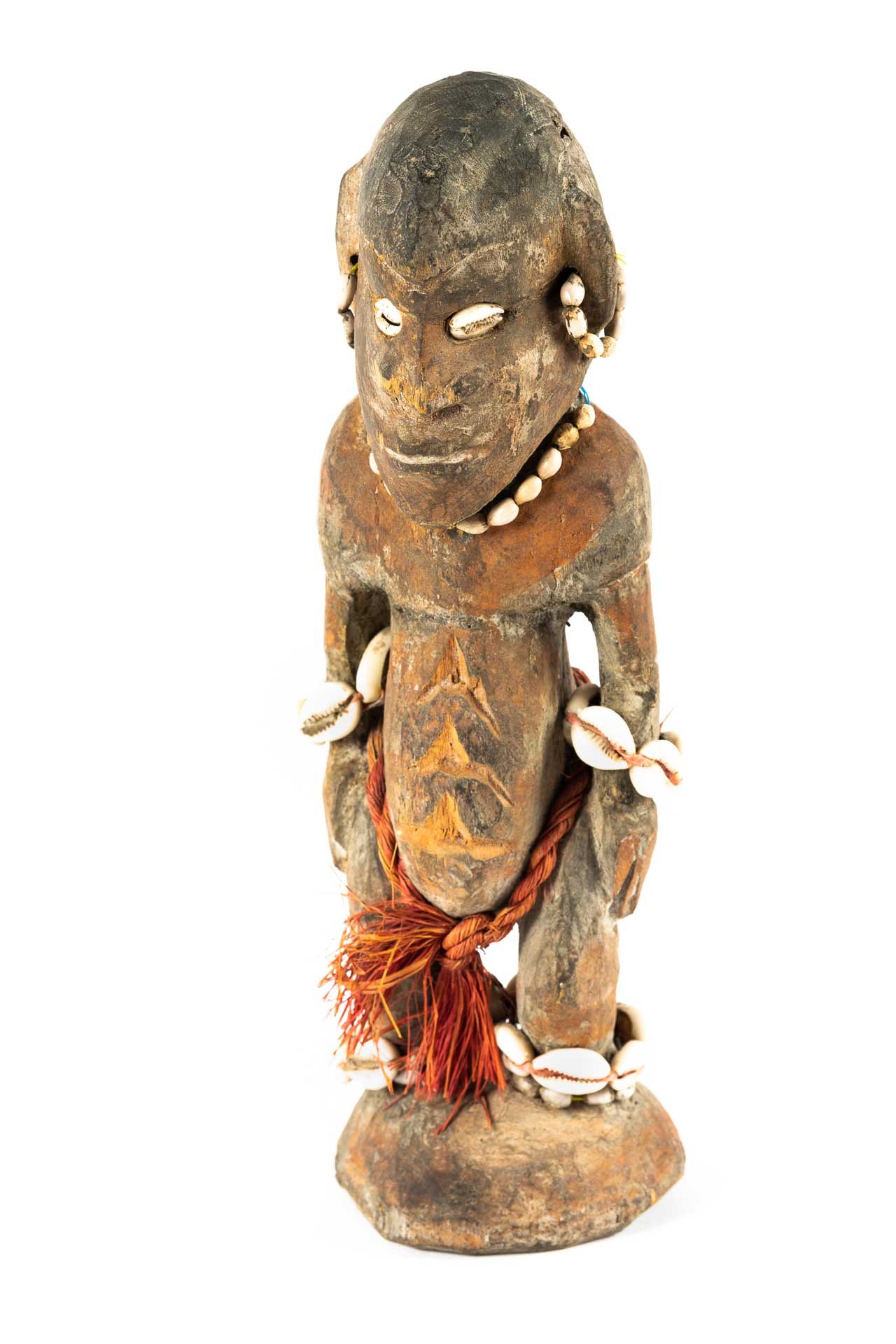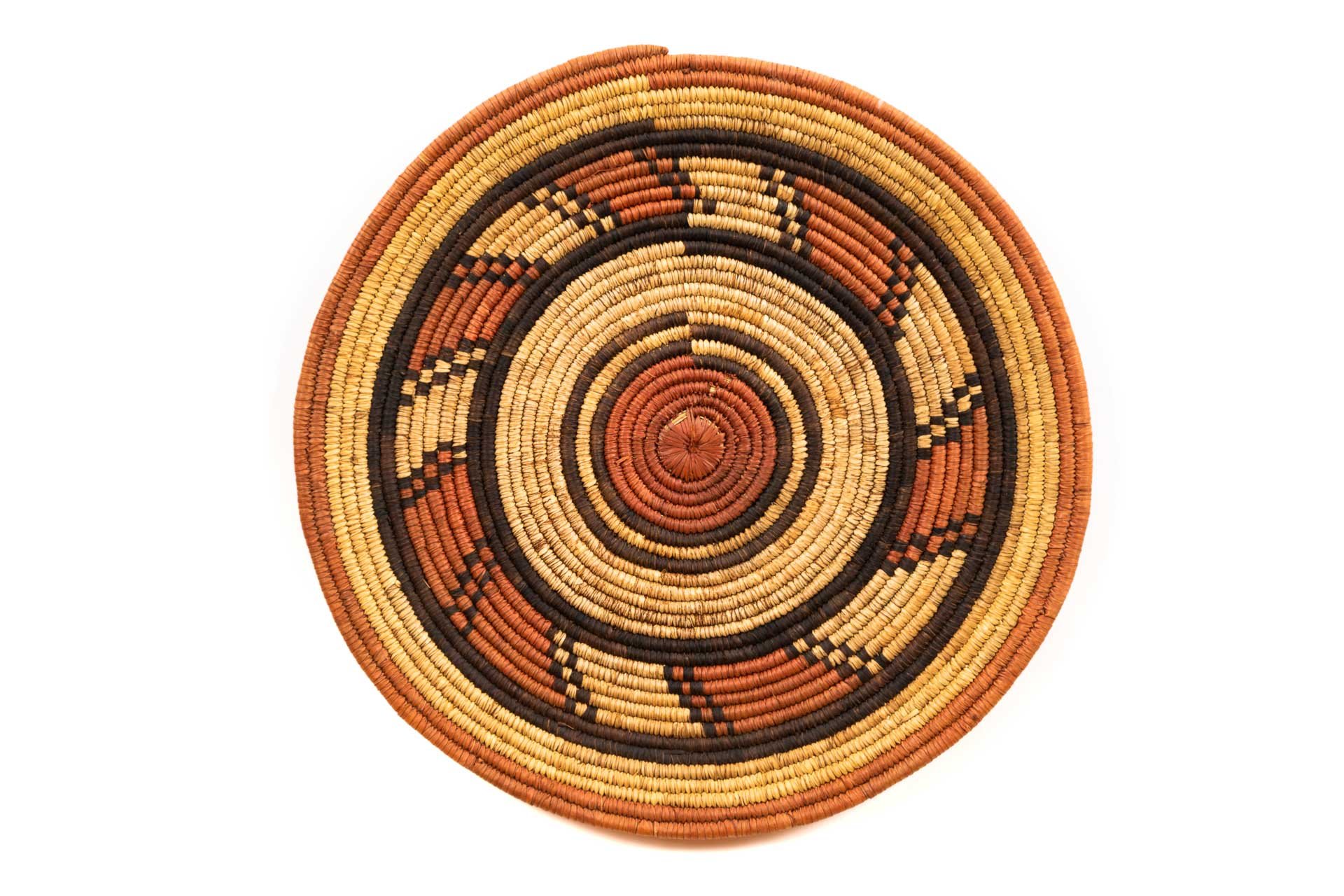In 2004, Norma Canelas and William D. Roth graciously gave Polk Museum of Art the seeds for a new collection of African art. This gift of 56 traditional pieces made from a variety of media include the Himba, San, Zulu, Ntwana, Swazi, Bhaca, Sotho, Ndebele, Thembu, Pedi, and Batonka cultures.

Senufo Mask, Ivory Coast, 20th Century, Wood, Gift of the Dr. Alan & Linda Rich Collection

The Chiwara, a creation of the Bambara people of West Africa, is the crowning piece of a crest mask worn by performers in a traditional dance ceremony that celebrates successful farming. It is named for Chi Wara, a divine figure in Bambara culture who taught humans to farm and cultivate land. Bambara philosophy correlates divine and mythical entities to animals. Accordingly, the Chiwara is an amalgamation of three Earth-burrowing animals: comprised of the head of an antelope, the body of an aardvark, and the scales of a pangolin.
To the Bambara, the male-female relationship is synonymous to the Sun-Earth relationship so fundamental to farming. In the traditional ceremony, performed to encourage farmers both during and after their harvest work, one dancer dons a “female” Chiwara, distinguished by a baby carried on its mother’s back, and the other dancer dons a “male” Chiwara, distinguished by a complex angular pattern on its body.
Bambara people, Mali (Africa), 20th century
Wood
Gift of the Dr. Alan & Linda Rich Collection
Wood relief-carving is a traditional art form of the peoples inhabiting the former Portuguese colony of Mozambique. Crafted by local artists, the reliefs often depict village and pastoral scenes, representing the everyday life and livelihood of the community. Carvings like this one out of mahogany traditionally decorate the main entrance of houses. Fittingly, this relief normally hangs over the entryway to the Riches’ home and was a gift from a thankful patient who lived in Mozambique.
Mozambique, 1899
Mahogany
Gift of the Dr. Alan & Linda Rich Collection
Jewelry and beadwork are indicators of a person’s social position. When it comes to earrings, for example, unmarried women wear smaller earrings while married women wear larger earrings, some the size of bookmarks. Male warriors also wear elaborate earrings as a demonstration of wealth or power, with warriors wearing circular gauges in their earlobes made from the cross-section of elephants’ tusks. The wearers often mismatch the colors of earrings or bracelets to represent dualities such as male and female or heaven and earth.
Masai people (Kenya), 20th century
Beading, tin, and wire
Gift of the Dr. Alan & Linda Rich Collection
The women and men of the Maasai wear much jewelry made from beads, animal horns, and bone. The bracelets are made from giraffe femurs, while the earrings are of animal horn. These were gifts from Rico to Linda during their courtship, collected while he was working in Kenya.
Masai people (Kenya), 20th century
Giraffe bone
Gift of the Dr. Alan & Linda Rich Collection
The sharing of snuff, which the Maasai make from a combination of tobacco and magadi (soda), is viewed as a sign of friendship and familiarity. This tobacco holder is made from leather and the femur of a giraffe, likely predating modern versions made of bamboo or synthetic materials.
Masai people (Kenya), 20th century
Bone, leather, and beading
Gift of the Dr. Alan & Linda Rich Collection
To the Maasai, illnesses are attributed either to a natural or supernatural cause. To treat the latter, patients rely traditionally upon a “medicine man” for healing. In the case of natural illnesses, the Maasai use remedies derived from plants and herbs to treat specific symptoms. Although the Maasai accumulate their knowledge of the healing possibilities of nature throughout their lives, much of their general understanding of biodiversity passes down orally from generation to generation. Traditional remedies — or “ethnomedicine” — are the most prevalent forms of medical care in developing regions, stemming largely from local belief systems and inaccessibility to modern care. Despite its dismissal in modern medical practice, several agencies such as the World Health Organization (WHO) have studied and even promoted the study of ethnomedicine for its potential benefits of self-reliance and quick treatment. The Shaman to whom this mask belonged was especially interested in Western clothing, trading Rico for a pair of blue jeans and polo shirt in exchange for the mask.
Maasai people (Kenya), 20th century
Fiber
Gift of the Dr. Alan & Linda Rich Collection
The Iatmul people espouse a firm connection with a religion that dominates all aspects of their daily and ritualistic lives, often referred to as “the life force.” Cult statues such as these represent ancestors and their life force spirits.
Iatmul people (Papua New Guinea), 20th century
Wood
Gift of the Dr. Alan & Linda Rich Collection
Among the most prominent and important symbols of the Maasai people is the warrior shield. The shield is a perfect example of the multifold functions of much Maasai art; shields are at once works of art, bearing the exquisite design motifs called sirata so familiar in the art of the region, and functional utilitarian and ritual objects at the same time. A shield like the one displayed here may be used for hunting and fighting (and training to learn how to hunt and fight), in ceremonial rites, or to display an individual or family’s prestige and honor.
Maasai shields, used in daily life, are made from wooden frames covered with the hide of cow or buffalo. The appearance of red and blue paint in this shield’s design indicates that it belonged to an accomplished warrior and herder, as inexperienced warriors were limited to using black, white, or gray on their shields. Despite the fact that the shields of the Maasai remain among the most widely known symbols of their culture — so much so that the shield is even featured on the Kenyan flag — the original meanings of many specific designs and symbols borne on the shields have been lost among the Maasai.
Maasai people, Kenya
Wood and hide
c. 20th century
The Iatmul people espouse a firm connection with a religion that dominates all aspects of their daily and ritualistic lives, often referred to as “the life force.” Cult statues such as these represent ancestors and their life force spirits.
Iatmul people (Papua New Guinea), 20th century
Wood
Gift of the Dr. Alan & Linda Rich Collection
Zulu people, South Africa, 20th century
Ebony and bone
Gift of the Dr. Alan & Linda Rich Collection
Cowrie shells serve both functional and artistic functions in Papua New Guinean culture. While the shells are used commonly as currency, they are also employed frequently as creative details for works of art. Indeed, given their shape and appearance, cowrie shells often represent eyes in masks and other sculptures.
Huli People, Papua New Guinea, 20th Century, Shell, String
Gift of the Dr. Alan & Linda Rich Collection
Yoruba masks have a characteristic coiffure similar to those seen in their statues.
Yoruba People, Nigeria, 20th Century, Wood
Gift of the Dr. Alan & Linda Rich Collection
Huli people, Papua New Guinea, 20th century
Bone, string
Gift of the Dr. Alan & Linda Rich Collection
Iatmul people, Papua New Guinea (Oceania), 20th Century
Wood
Gift of the Dr. Alan & Linda Rich Collection
This mask, also known as a Helmet or Dream mask, is worn atop the head and has no eyeholes. With its prominent elongated and arched nose, the mask’s features are characteristic of Sepik river masks. Often worn ceremonially, masks like these represent and seek to honor specific mythical ancestors and supernatural siblings. This mask was a gift to the Riches from a grateful Iatmul chief.
Iatmul people, Papua New Guinea, c. 20th Century
Rattan, wood, fiber
Gift of the Dr. Alan & Linda Rich Collection
Cast in brass using the lost-wax technique, the Kuduo is a container made for kings and courtiers of the Ashanti. Its owner would store items of value inside, including gold dust, used as currency in trade with both Africans and Europeans, as well as other items of personal significance. A Kuduo also served as a symbol of the owner’s kra, or “life force,” having a role in ceremonies protecting the well-being of the individual. After kings or courtiers’ passing, their Kuduos were filled with gold and other offerings in a funerary ceremony and left at the burial site.
This Kuduo is relatively large, with an intricate base and ornate zig-zag pattern. The brass goldweights on its lid depict a king seated in an akonkromfi chair surrounded by musicians.
Ashanti people, Ghana, c. 20th Century
Brass
Gift of the Dr. Alan & Linda Rich Collection
The Akua Ba is a doll carried by Akan women hoping to conceive and birth a child. The dolls are usually female, as the Akan are a matrilineal people whose mothers often hope to bear female descendants to continue their line. The Akua Ba derives its name from an Akan legend in which a woman named Akua could not conceive children, so she constructed and carried a doll as if it were her child, only to be teased by others. Ultimately, Akua had a successful conception and gave birth to a daughter, so other women began the practice of carrying dolls. Akua Ba translates to “Akua’s child.” Families will keep each child’s doll as an heirloom, memorializing their children and the spirits.
The doll’s flat and cylindrical construction allows easy carrying by the hopeful mother, and its body depicts Akan ideals of beauty for infant children: a round forehead, rings on the neck signifying rolls of fat (seen as signs of health and strength), and delicate facial features. The small lines underneath the eyes depict scars given in a medical practice believed to prevent convulsions.
West Africa, c. 20th Century
Wood
Gift of the Dr. Alan & Linda Rich Collection
Amulet bracelets like these are believed to be bestowed with magical powers and provide protection and healing for their wearers. The crocodile and cobra represent animal spirits of strength, power, alertness, and quick response, which in turn become part of the wearer’s life skills. This power of suggestion is part of a West African belief system of animal virtues connected to the life force.
Ashanti people, Ghana, c. 20th century
Brass
Gift of the Dr. Alan & Linda Rich Collection
This figure may be based on the sankofa bird of Akan tradition in West Africa. Translating as “go back and fetch it,” the sankofa represents learning from the past in a way that benefits the future and is depicted as a bird turning its head backwards with its feet facing forward. This symbol more often includes the depiction of the bird retrieving an egg with its beak.
Zulu People, South Africa, 20th Century, ebony, bone
Gift of the Dr. Alan & Linda Rich Collection
Unknown Artist, Zambia, 20th century
Fiber
Gift of the Dr. Alan & Linda Rich Collection
Unknown Artist, Papua New Guinea, 20th century
Beads
Gift of the Dr. Alan & Linda Rich Collection
Unknown Artist, Papua New Guinea, 20th century
Tortoise shell
Gift of the Dr. Alan & Linda Rich Collection
Huli Wigmen, Papua New Guinea, 20th century
Wood
Gift of the Dr. Alan & Linda Rich Collection
Bambara people, Mali, 20th century
Wood, fiber, cowrie shell, and metal
Gift of the Dr. Alan & Linda Rich Collection
This statue underlines the Iatmul belief that all life is connected — from human to bird to crocodile, a unity of the “life force.” In Iatmul culture, the crocodile represents maturation and male initiation into manhood, transitioning from one stage of adolescence to another. Crocodiles can also symbolize a desire for order and defense against disintegration and chaos. Here, the crocodile’s upper and lower jaws represent the “upper” and “lower” worlds of Sepik belief. Crocodiles are so familiar a symbol for Papua New Guinea that Sepik canoes are built to emulate the reptile’s shape. This statue was a gift to the Riches from an Iatmul chief.
Iatmul people, Papua New Guinea, 20th century, wood
Gift of the Dr. Alan & Linda Rich Collection






























